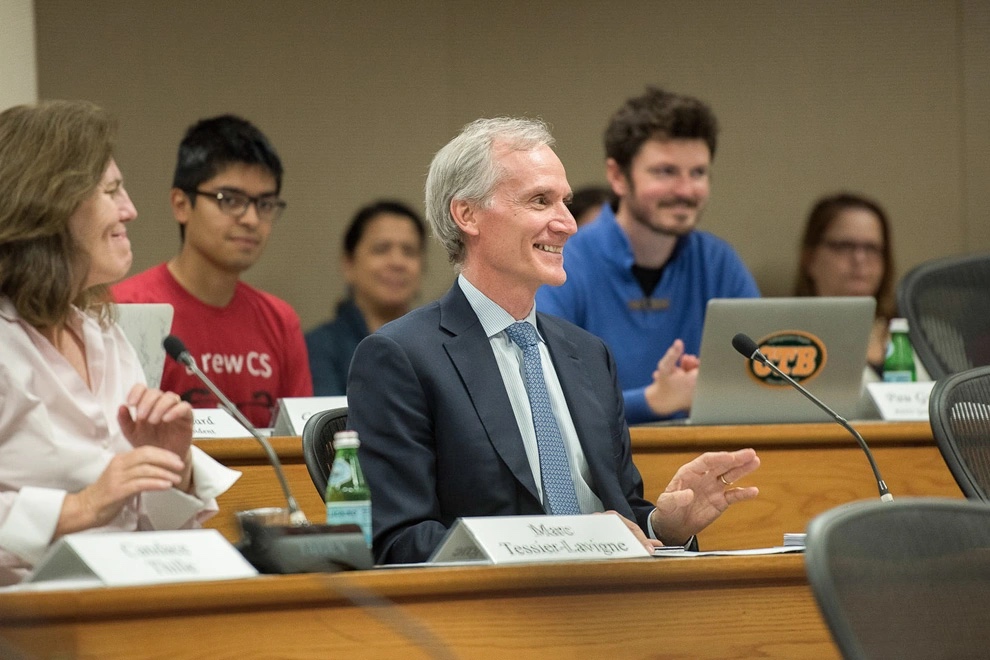To Members of the Stanford Community:
In light of the publicity and discussions surrounding papers published by President Marc Tessier-Lavigne, and as Stanford faculty members who conduct biological and biomedical research, we would like to provide our Stanford community of faculty, staff, and students with our perspective on these issues. Scientific integrity and data reproducibility are paramount to what we do. Nevertheless, errors do occur in science — and when they do, there are several options for making corrections, depending on the severity of the error. Questioning a researcher’s scientific integrity is a very serious allegation that should not be confounded with the detection of errors in a few papers, particularly against a backdrop of work that has been widely replicated by others. Indeed, the scientific process is inherently error-correcting as researchers test the validity of published work and construct robust fields based on foundational discoveries.
As faculty members and principal investigators in contemporary biological laboratories, we work closely with our graduate students and postdoctoral trainees to ensure the accuracy of our experimental work. However, advancing scientific frontiers increasingly requires larger teams of scientists who bring distinct sets of expertise to a study. In science, as in all realms of life, mistakes are inevitable. We strive to build a culture that aims not to punish mistakes made by trainees or one another, but instead encourages criticism and provides authors the opportunity to correct errors. Our scientific contributions will ultimately be tested by colleagues who examine our discoveries and extend them into new domains.
The Stanford Daily has published a series of articles in recent weeks raising concerns about several papers related to President Tessier-Lavigne that contain possibly digitally altered or partially duplicated figures. Among these papers, President Tessier-Lavigne was listed as the corresponding author (also known as the senior author) on three (papers published in 1999 and 2001). We believe that a formal review is appropriate for these three papers. President Tessier-Lavigne has stated (and each journal has confirmed) that after problems with the figures were spotted many years ago, he contacted the journals’ editors to resolve these issues, but that the journals failed to publish the corrections or take further action. In addition, new concerns have been raised with two of the papers. We feel that it is appropriate to investigate the questioned images and communications with the editors of the journals. We hope that the Board of Trustees and experts in the field will be able to resolve the questions about these papers and identify an appropriate course of action to address any errors.
Regarding the other papers, the figures in question were generated in the labs of the senior authors and not in President Tessier-Lavigne’s laboratory. Six of the corresponding authors stated on PubPeer that the data in question were from their own laboratories and have taken responsibility for any errors. The authors of five of the papers have already offered explanations for these errors. In one, alterations to figures were made by the publisher (who changed the font of the panel labels) and not by any of the authors.
As scientists, our greatest fear is that we might publish a paper that contains errors. That said, in the case of collaborations between multiple laboratories, and especially for international collaborations, it is not always possible for collaborators to see all the primary data, which might include X-ray films of biochemical gels showing proteins or nucleic acids of different sizes and abundance, sections of tissue visualized and photographed under a microscope, or analyses of the physiological responses or behavior of living cells or animals. In our opinion, it is unfair to question a scientist’s integrity based on images produced from a collaborator’s laboratory. Holding every author to an identical standard of responsibility would require a level of scrutiny of primary data that could stifle scientific collaboration and productivity.
In the case of President Tessier-Lavigne, core discoveries made by his laboratory have not only stood the test of time after validation by laboratories around the globe, but have also served as a foundation for the field of axon guidance. President Tessier-Lavigne’s discovery of families of axon guidance molecules and their receptors has revolutionized our understanding of how the brain is wired. These accomplishments do not guarantee that every paper he has authored is free of errors, but collectively they demonstrate a high level of scientific rigor and reproducibility. We hope that the investigation of the three articles under question will be balanced, fair, and informed by an understanding of how scientific collaborations are conducted. We also hope that members of our community will not rush to judgment until the review is completed.
Sincerely yours (in alphabetical order),
Aaron D. Gitler (Professor of Genetics)
Liqun Luo (Professor of Biology and Member, National Academy of Sciences)
Robert Malenka (Professor of Psychiatry and Behavioral Sciences and Member, National Academy of Sciences and National Academy of Medicine)
Susan K. McConnell (Professor of Biology and Member, National Academy of Sciences)
William T. Newsome (Professor of Neurobiology and Member, National Academy of Sciences)
Carla J. Shatz (Professor of Biology and Neurobiology and Member, National Academy of Sciences and National Academy of Medicine)
Kang Shen (Professor of Biology and Howard Hughes Medical Institute Investigator)
